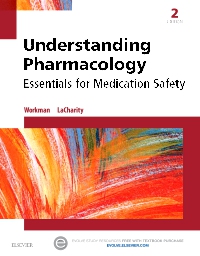
Understanding Pharmacology - Elsevier eBook on VitalSource, 2nd Edition
Elsevier eBook on VitalSource

Don’t settle for rote memorization when you can give your students a solid understanding of specific drugs and broader pharmacology concepts. Understanding Pharmacology: Essentials for Medication Safety, 2nd Edition uses a unique combination of simplified language, easy-to-follow headers, and engaging boxes and icons — such as Memory Joggers, Clinical Pitfalls, Do Not Confuse, and Drug Alerts — to help your students really understand how drugs work instead of simply memorizing drug information. In addition to the popular critical thinking activities from the first edition, the second edition also includes more chapter review questions, updated content, and a new organization centered on the different body systems to ensure students are equipped with all the tools and information they need to safely prepare or administer drugs.
Newer Edition Available
Understanding Pharmacology - Elsevier eBook on VitalSource
-
- NEW! Body system organization helps students better understand drugs that are specific to particular body systems
- NEW! More chapter review questions have been added to the text. All review questions are now organized into one of two categories: Test Yourself on the Basics and Test Yourself on Advanced Concepts
- NEW! Test bank questions now organized by nursing and health professions help instructors better sort and organize questions that pertain to their specific programs
- Entire unit reviewing math, weights and measures, and dosage calculation minimizes students’ anxiety and promotes medication safety
- Drug Alert!, Do-Not-Confuse, and Clinical Pitfall boxes highlight important tips for safe medication administration
- Clever, easy-to-recognize margin icons help visual learners remember essential side effects of drugs
- Incorporation of adult learning theory features both a simple to complex organization of material along with answers to why students need to learn something
- Simplified heading structure replaces intimidating terminology (i.e. pharmacokinetics) with simplified language (How These Drugs Work) to increase understanding of concepts
- Get Ready for Practice sections at the end of each chapter include key points, chapter review questions, and critical thinking activities to reinforce learning
- Memory Jogger boxes help students remember important drug information
- 10th grade reading level uses straightforward, everyday language to really enhance students’ understanding of pharmacology concepts
-
- NEW! Body system organization helps readers better understand drugs that are specific to particular body systems
- NEW! More chapter review questions have been added to the text. All review questions are now organized into one of two categories: Test Yourself on the Basics and Test Yourself on Advanced Concepts
-
UNIT I: General Aspects of Pharmacology
1. Drug Regulation, Actions, and Responses
2. Safely Preparing and Giving Drugs
UNIT II: Mathematics for Pharmacology and Dosage Calculation
3. Mathematics Review and Introduction to Dosage Calculations
4. Medical Systems of Weights and Measures
5. Dosage Calculation of Intravenous solutions and Drugs
UNIT III: Pharmacology For Multisystem Application
6. Anti-Inflammatory Drugs
7. Drugs for Pain Control
8. Anti-Infectives: Antibacterial Drugs
9. Anti-Infectives: Antiviral Drugs
10. Anti-Infectives: Antitubercular and Antifungal Drugs
11. Immunizations
12. Anticancer Drugs
Unit IV: Drug Therapy for Endocrine Problems
13. Drug therapy for Diabetes
14. Drug Therapy for Thyroid and Adrenal Gland Problems
Unit V: Drug Therapy for Problems of the Circulatory and Cardiac Systems
15. Drug Therapy Affecting Urine Output
16. Drug Therapy for Hypertension
17. Drug Therapy for Heart Failure
18. Drug Therapy for Dysrhythmias
19. Drug Therapy for High Blood Lipids
20. Drug Therapy to Disrupt Clotting
Unit VI: Drug Therapy for Respiratory System Problems
21. Drug Therapy for Asthma, Chronic Obstructive Pulmonary Disease, and Pulmonary Fibrosis/Hypertension
Unit VII: Drug Therapy for Gastrointestinal System Problems
22. Drug Therapy for Gastrointestinal Dysfunction
23. Drug Therapy for Gastric Ulcers and Reflux
24. Drug Therapy with Nutritional Supplements
Unit VIII: Drug Therapy for Nervous System Problems
25. Drug Therapy for Seizures
26. Drug Therapy for Parkinson’s and Alzheimer’s Diseases
27. Drug Therapy for Psychiatric Problems
28. Drug Therapy for Insomnia
29. Drug Therapy for Eye Problems
Unit IX: Drug Therapy for Problems of the Musculoskeletal System
30. Drug Therapy for Osteoporosis and Muscle Relaxation
Unit X: Drug Therapy for Problems of the Reproductive System
31. Drug Therapy for Male Reproductive Problems
32. Drug Therapy for Female Reproductive Problems



 as described in our
as described in our 